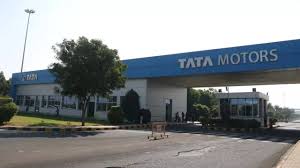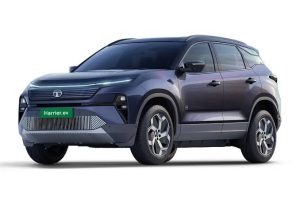Digital News Guru Technology Desk:
India’s EV Push: Tata Motors Commits Rs 33–35k Crore (≈ US $4.1 B) for FY26–30
On June 9, 2025, Tata Motors unveiled a bold investment blueprint: allocate Rs 33,000–35,000 crore (approximately US $4.1 billion) over the next five fiscal years (FY26–30). This strategic capital outlay is primarily aimed at expanding its electric vehicle (EV) and compressed natural gas (CNG) portfolio, accelerating new model launches, and bolstering EV infrastructure—positioning the company for leadership in India’s fast-growing clean-car segment.
The Big Picture: Goals and Justifications
- Doubling the EV Model Range
Tata currently offers eight EV/CNG models and intends to increase that to 15 over the next five years. This lineup includes upcoming premium models such as the Harrier.ev, Sierra.ev, Curvv.ev, and Avinya.ev, alongside further expansion of the popular Nexon.ev, Punch.ev, and Tiago.ev

- Aggressive Market Share Targets
With this launch cadence, Tata targets increasing its passenger vehicle market share from around 16% by March 2027 to 18–20% by March 2030, riding a wave of growing EV trends and stringent emission standards slated for 2027.
- Alignment with National EV Goals
India aims to ensure that 30% of new car sales are electric by 2030. Tata’s investment is well-aligned: with EVs accounting for less than 3% of car sales now, the company plans to elevate its EV penetration to 30% of its own sales by 2030, up from 12–13% in FY24.
Strengthening EV Ecosystem: Batteries & Charging
Local Battery Production via Gigafactory
In a bid to cut battery costs and ensure supply chain resilience, Tata Group is investing US $1.5 billion in a battery gigafactory in Gujarat, set to begin production in 2026, with full capacity by 2028. This will help control costs for the most expensive EV component—battery cells—and reduce dependency on imports.
Expanding Charging Infrastructure
Recognizing range anxiety as a key barrier to EV adoption, Tata Motors has begun installing public fast-charging stations—free for early adopters—and is working with partners like ChargeZone, HPCL, and Shell to expand networks. Plans include growing from 10,000 to 100,000 chargers by FY30.
Premium EV Lineup: Harrier.ev, Sierra.ev, Curvv.ev & Beyond
Tata’s upcoming Harrier.ev—launched June 3, 2025—is its first mid-size, premium SUV built on the acti.ev Plus modular platform. With up to 627 km range (MIDC) and advanced features like all-wheel drive and ADAS, it marks Tata’s entry into upscale EV territory.
Other models under development include:
- Sierra.ev and Avinya.ev (slated FY26 launch),
- Curvv.ev coupe (launching soon),
- Premium Jag-based models on new EVA platform.
This signals a clear shift from mass-market “green minis” to premium electric offerings.

Competitive Edge & Industry Context
Rising Competition
Tata EV market share dropped from 73% in 2023 to ~62% in 2024, as rivals like MG (Windsor), Mahindra, Hyundai, Maruti Suzuki, and even Tesla pose stiffer competition.
Integrated Supply Chain Advantage
Unlike many competitors, Tata aims for greater vertical integration—building its own batteries and charging stations, backed by funding including US $1 billion from TPG and subsidized by government incentives of approximately US $750 million.
Global Reach & JLR Support
Although this investment focuses on India’s passenger-vehicle arm, overall Tata Group plans across its global operations (including JLR) total approximately Rs 43,000 crore in FY25.
Investment Roadmap & Spending Breakdown
| Timeframe | Investment & Initiatives |
| FY26–30 | Rs 33–35k crore capex for EV/CNG launch and electrification |
| FY26 | Launch of Harrier.ev, Curvv.ev, Sierra.ev |
| FY27–30 | EV sales share target 16→18–20%; 30% of Tata’s sales electric |
| 2026 | Battery gigafactory starts production |
| 2028 | Full-scale battery production; reduce battery costs |
| FY25 | Rs 43k cr group capex including Rs 35k cr for JLR; ~Rs 8k cr for PV biz |
Why This Matters
- Pivot to Electrification: The hefty investment reflects Tata’s conviction in EV growth and regulatory alignment—setting new benchmarks for India’s automotive transition.
- Model & Tech Leap: Moving from hatchbacks to premium, long-range SUVs, Tata widens its brand appeal and price spectrum.
- Chain Integration: Battery-making and rapid charging build supply security and cost efficiency—differentiators against rivals.
- Market Leadership Ambitions: The firm clearly aims to surpass Hyundai, Mahindra & Mahindra, and others to dominate EV and ICE segments by 2030.
Road Ahead: Opportunities & Risks
- Opportunity: With falling battery costs, expanding product line, and growing EV infrastructure, Tata is well-placed to lead India’s clean mobility shift.
- Risk: Competition is intensifying—from MG, BYD, Maruti, Hyundai, and potential Tesla entry. Additionally, Tata must execute rollout without cost overruns, and ensure after-sales quality remains strong—a pain point cited by some customers.
- Government Policy: Ensuring incentives continue and automotive regulations bolster EV adoption will be critical—though supportive trends such as new EV import duties are in the favor of local manufacturers .

Final Word
Tata Motors’ Rs 33–35,000 crore investment for FY26–30 marks a turning point in India’s automotive industry. It demonstrates a full-fledged commitment to electrification: more models, integrated battery production, and stronger infrastructure. With ambitious market share goals and aligned national policy, Tata is setting itself up as the flagship of India’s EV ride—but it’s a high-stakes bet.
Success will depend on execution across its premium lineup, cost management, and after-sales excellence. If it delivers, Tata will cement its position as EV front-runner—not just in India, but as a rising global EV powerhouse.
You May Also Read: NBK111: Balakrishna & Gopichand Malineni Reunite for a Grand Historical Spectacle








